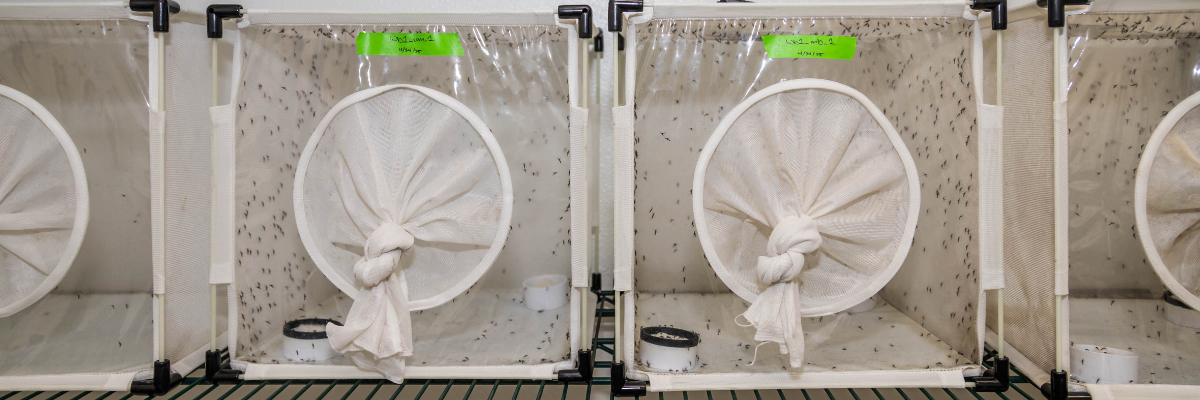Frequently Asked Questions: SGV Mosquito Match

General Information
There are a number of methods using male mosquitoes to prevent successful breeding in a pest population. Many techniques use males that are sterilized. A similar technique is to use Wolbachia, a common bacteria found naturally in many insects in our area. Please see our Sterile Insect Techniques (S.I.T.) page for more information. The main goal of all of these techniques is to introduce males into the pest population to mate with wild females which will result in eggs that fail to hatch.
The acronym I.I.T. stands for Incompatible Insect Technique. The Wolbachia-infused males in the Bassett project are called WB1 males and are reared by MosquitoMate. Wild females that mate with WB1 males lay eggs that never develop into living offspring.
The concept and the goals of I.I.T. are the same as S.I.T.. The use of Wolbachia as a control method is usually included under the much broader Sterile Insect Technique (S.I.T.) designation when communicating with the public.
Female mosquitoes mate with only one male once in their life. If large numbers of WB1 males are released into an area, they will outcompete the wild males, resulting in fewer eggs hatching. The goal through repeated releases is the reduction of the overall size of that particular population of mosquitoes.
Yes, this common bacteria lives naturally and harmlessly in the environment. It is found only in insects and similar animals and does not harm humans, pets, or wildlife – including native pollinating insects.
No. We are releasing only male mosquitoes which don’t bite and don’t spread any diseases.
This program focuses on the control of Aedes aegypti, a tropical mosquito species that invaded southern California in 2011. These mosquitoes are known to transmit dengue, zika, and yellow fever.
No, Wolbachia is a bacteria that survives only in insects, spiders and related animals, and nematode worms.

Implementation & Effectiveness
They are released from individual containers by hand. Each container holds WB1 male mosquitoes. Staff will perform releases at designated points within the release area.
For 2025, mosquito releases will occur over the course of 1-2 days. In 2026, mosquitoes will be released for 16 weeks.
To see a reduction in the mosquito population, multiple sustained releases of WB1 male mosquitoes need to occur. This will take place in 2026. By initiating releases early in the season, before peak Aedes activity, we aim to curb the population in and around the release area. A reduction in the mosquito population in the treatment area is a goal for fall 2026.
Yes. Please continue to apply insect repellent and empty standing water sources. These releases are aimed to be an additional tool to control mosquitoes, but they do not replace traditional practices. Continue to practice all prevention measures to reduce mosquito-borne diseases, which includes tipping out standing water, tossing out unused containers, and using insect repellent. Please see our page on Aedes mosquitoes for the best way to keep these mosquitoes away from your home.
This is one more tool in our toolbox, but each tool has a specific use and purpose. Currently, this only addresses one species of mosquito. We expect this method to improve over time, but it will not completely replace traditional mosquito control practices. The use of WB1 male mosquitoes is one proactive technique to use in response to a growing population of mosquitoes that may pose a future disease risk.

Wolbachia in the Environment
Wolbachia is only passed on from the male mosquito to the female during mating. Research has found Wolbachia to be a common harmless bacteria present in many species of insects, including bumble bees and other native bees [1].
[1] Nanetti A, Bortolotti L, Cilia G. Pathogens Spillover from Honey Bees to Other Arthropods. Pathogens. 2021 Aug 17;10(8):1044. doi: 10.3390/pathogens10081044. PMID: 34451508; PMCID: PMC8400633.
Wolbachia is already naturally present in many species in the environment. To date, there is no evidence indicating that Wolbachia will change in the near future [2].
[2] Kaur R, Shropshire JD, Cross KL, Leigh B, Mansueto AJ, Stewart V, Bordenstein SR, Bordenstein SR. Living in the endosymbiotic world of Wolbachia: A centennial review. Cell Host Microbe. 2021 Jun 9;29(6):879-893. doi: 10.1016/j.chom.2021.03.006. Epub 2021 May 3. PMID: 33945798; PMCID: PMC8192442. https://pmc.ncbi.nlm.nih.gov/articles/PMC8192442/#:~:text=In%20the%201990s%2C%20entomologists%20and,living%20in%20the%20Wolbachia%20world.
No, there is no risk to biodiversity. The targeted mosquito species, Aedes aegypti mosquitoes, are not native to California. Male Aedes mosquitoes only mate with females of the same species so this will have no effect on local Culex mosquitoes.
Releasing WB1 male mosquitoes in large numbers is an essential component of this technique. However, since male mosquitoes don’t bite, this program will not increase the number of biting mosquitoes. The ultimate goal is a reduction in the overall Aedes aegypti mosquito population after repeated releases of WB1 males.
The male Aedes mosquitoes are not genetically modified. But are reared to carry a Wolbachia bacteria strain not found in wild female Aedes mosquitoes. This difference between the male and female creates an incompatibility during pairing that results in eggs that fail to hatch. Since the female mosquito only mates once in her life, all the eggs she will lay over her lifetime will not develop into living offspring. To see more about this phenomenon and similar sterile insect techniques please see our website page, Sterile Insect Technique (SIT).

Community Engagement & Costs
No.
This program is part of the San Gabriel Valley Mosquito and Vector Control District regular mosquito control activities. While our agency is taxpayer supported, the cost of the program is part of our agency’s regular operating budget.
No, currently SGVmosquito’s program is taking place only in Bassett this year. However, there are separate programs being implemented by other vector control districts across the county.
No, it isn’t possible for residents to opt out.
Please contact our office at district@sgvmosquito.org or 626-814-9466.
